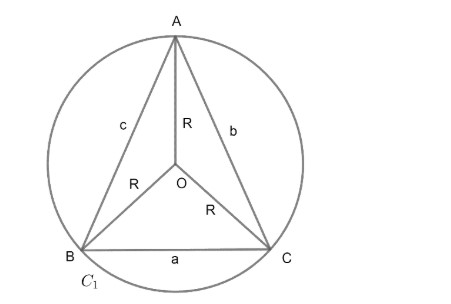Question
Question: If R is the radius of circumcentre of \(\Delta ABC,\) then \(R=\dfrac{abc}{4S}\) (A) True (B) ...
If R is the radius of circumcentre of ΔABC, then R=4Sabc
(A) True
(B) False
Solution
Hint: Use area of triangle formula, where two sides of triangle and angle between them is given. Use sine rule related with circumradius to get the given relation.
Complete step-by-step answer:
Here, we have given R as a radius of circumcircle i.e. circumradius and need to prove the relation;
R=4Sabc……………….(1)
Where (a, b, c) are sides of the triangle as denoted in the diagram.

Where O is the centre of the circle C, which is circumscribing the triangle ABC.
R = Circumradius of triangle ABC.
We can write sine rule in ΔABC involving circumradius R as;
asinA=bsinB=csinC=2R1..............(2)
As we have a formula of area with involvement of two sides and angle between them.
Let the area be represented by S.
Area=S=21bcsinA=21absinC=21acsinB........(3)
Now, from equation (2) and (3), we can write an equation with respect to one angle as
asinA=2R1 and S=21bcsinA
Substituting value of sin A from the relation asinA=2R1 to S=21bcsinA, we get;
As sinA=2Ra from the first relation, now putting value of sin A in S=21bcsinA, we get
S=21bc2RaS=4Rabc
Transferring R to other side, we get;
R=4Sabc
Hence, the relation given in the problem is true.
Note: One can go wrong with the formula of area of the triangle. One can apply heron’s formula for proving i.e.
S=s(s−a)(s−b)(s−c)s=2a+b+c
Which will make the solution very complex.
One can go wrong while writing sine rule as;
asinA=bsinB=csinC=12R which is wrong.
Correct equation of sine rule will be,
asinA=bsinB=csinC=2R1.
